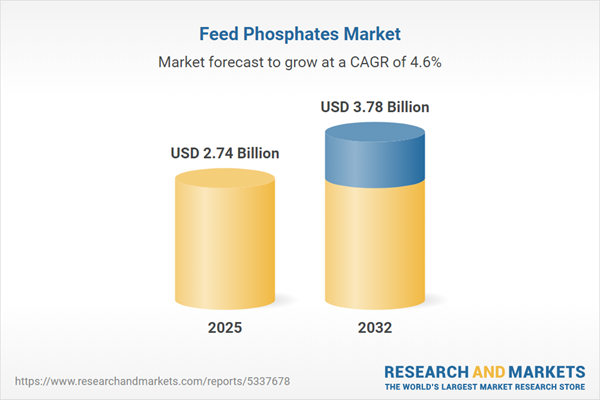Speak directly to the analyst to clarify any post sales queries you may have.
Senior decision-makers in the feed phosphates market face an environment influenced by evolving standards, rising sustainability demands, and complex regulatory oversight. Navigating these changes requires data-driven strategies, operational agility, and robust industry insights to secure long-term growth and competitive positioning.
Market Snapshot: Feed Phosphates Market Size, Growth Rate, and Outlook
The feed phosphates market is projected to reach USD 2.63 billion in 2024 and will expand to USD 2.74 billion in 2025, reflecting a compound annual growth rate (CAGR) of 4.64%. Revenue is forecasted to rise further and will approach USD 3.78 billion by 2032. Growth is driven by sustained demand for animal protein, continuous advancements in feed formulations, and integration of advanced nutritional additives. Leading organizations prioritize adaptive procurement, compliance initiatives, and engagement with sustainability frameworks, enabling them to meet evolving producer and consumer expectations while increasingly complex global supply networks prompt agile responses throughout the value chain.
Scope & Segmentation: Feed Phosphates Market Analysis
Comprehensive segmentation within the feed phosphates market provides a foundation for effective product development, risk management, and compliance strategies that span diverse industry applications and geographic markets:
- Phosphate Types: Defluorinated, dicalcium, monocalcium, and tricalcium phosphates are optimized for both livestock and poultry nutrition, supporting therapeutic and dietary needs according to regulatory standards.
- Form Variations: Granular feed phosphates are suited for efficient and consistent production flows, while powdered options enable flexible formulation to address specific dietary requirements or regional feeding practices.
- Distribution Channels: Companies utilize established offline distributors and are increasingly turning to digital procurement solutions to enhance supply chain reliability, transparency, and management efficiency.
- Application Areas: Feed phosphates play a vital role in animal health and performance for poultry, swine, ruminants, aquaculture, and companion animals, fostering sector-wide outcomes and compliance objectives.
- Geographical Regions: Strategic approaches vary by region, such as the Americas, EMEA, and Asia-Pacific, ensuring market entry, resource allocation, and partnership models align with local compliance frameworks and access landscapes.
- Key Technologies: Nano- and microparticle engineering advances increase nutrient bioavailability and animal health, while process improvements such as enhanced membrane filtration and defluorination contribute to safe and sustainable production.
Key Takeaways for Market Leaders
- Utilize advanced nutritional modeling to develop tailored feed solutions that keep pace with changing animal health and compliance requirements in various production systems.
- Implement rigorous quality assurance practices throughout all operational stages to minimize the risk of supply disruptions and regulatory deviations.
- Adopt alternative or recycled feedstock approaches to diversify sources, reduce input volatility, and enhance supply chain resilience.
- Modernize procurement by leveraging digital tools, which can strengthen supplier relationships, streamline processes, and improve responsiveness to evolving market conditions.
- Forge partnerships in logistics and supply, ensuring more consistent operations and risk mitigation across the value chain.
- Invest continuously in technology upgrades and process optimization to maintain regulatory alignment and achieve efficient production standards.
Tariff Impact: Navigating Shifting Trade Policies
Shifts in global tariff regimes, especially from recent U.S. policy changes, have compelled suppliers to reassess sourcing models and rethink inventory practices. Expanding logistics networks and securing additional storage are practical responses to safeguard against interruptions and sustain operational continuity in an unpredictable trade environment.
Methodology & Data Sources
This feed phosphates market research utilizes a blend of expert interviews, analysis of industry literature, regulatory documentation, and global trade data. All projections are corroborated by independent market professionals through a multi-stage vetting process, ensuring validity and decision-making utility.
Why This Feed Phosphates Market Report Matters
- Granular trend analysis and in-depth segmentation empower executives to anticipate key demand shifts and strengthen market adaptation strategies.
- Detailed compliance reviews and risk mapping aid in smooth regulatory navigation, reducing potential business disruptions.
- Comprehensive assessment of technologies and collaborative supply models help build resilient, adaptable value chains to address new challenges.
Conclusion
This report provides senior leaders with the insights to adjust strategies as market, regulatory, and technological factors change, supporting informed decision-making and ongoing business growth in the feed phosphates sector.
Additional Product Information:
- Purchase of this report includes 1 year online access with quarterly updates.
- This report can be updated on request. Please contact our Customer Experience team using the Ask a Question widget on our website.
Table of Contents
3. Executive Summary
4. Market Overview
7. Cumulative Impact of Artificial Intelligence 2025
Companies Mentioned
The companies profiled in this Feed Phosphates market report include:- OCP Group
- The Mosaic Company
- Innophos Holdings, Inc.
- Prayon SA
- PhosAgro Group
- EuroChem Group AG
- Chemische Fabrik Kalk GmbH & Co. KG
- Coromandel International Limited
- Yara International ASA
- DuPont de Nemours, Inc.
- Nutrien Ltd.
- J.R. Simplot Company
- FOSFITALIA SPA
- AB LIFOSA
- Reanjoy Laboratories
- Wengfu Group
Table Information
| Report Attribute | Details |
|---|---|
| No. of Pages | 192 |
| Published | October 2025 |
| Forecast Period | 2025 - 2032 |
| Estimated Market Value ( USD | $ 2.74 Billion |
| Forecasted Market Value ( USD | $ 3.78 Billion |
| Compound Annual Growth Rate | 4.6% |
| Regions Covered | Global |
| No. of Companies Mentioned | 17 |









